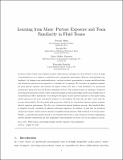Learning from Many: Partner Exposure and Team Familiarity in Fluid Teams
Author(s)
Jonasson, Jonas Oddur
DownloadSubmitted version (2.323Mb)
Open Access Policy
Open Access Policy
Creative Commons Attribution-Noncommercial-Share Alike
Terms of use
Metadata
Show full item recordAbstract
In services where teams come together for short collaborations, managers are often advised to strive for high team familiarity so as to improve coordination and consequently, performance. However, inducing high team familiarity by keeping team membership intact can limit workers’ opportunities to acquire useful knowledge and alternative practices from exposure to a broader set of partners. We introduce an empirical measure for prior partner exposure and estimate its impact (along with that of team familiarity) on operational performance using data from the London Ambulance Service. Our analysis focuses on ambulance transports involving new paramedic recruits, where exogenous changes in team membership enable identification of the performance effect. Specifically, we investigate the impact of prior partner exposure on time spent during patient pickup at the scene and patient handover at the hospital. We find that the effect varies with the process characteristics. For the patient pickup process, which is less standardized, greater partner exposure directly improves performance. For the more standardized patient handover process, this beneficial effect is triggered beyond a threshold of sufficient individual experience. In addition, we find some evidence that this beneficial performance impact of prior partner exposure is amplified during periods of high workload, particularly for the patient handover process. Finally, a counterfactual analysis based on our estimates shows that a team formation strategy emphasizing partner exposure outperforms one that emphasizes team familiarity by about 9.2% in our empirical context.
Date issued
2020-06Department
Sloan School of ManagementJournal
Management Science
Publisher
Institute for Operations Research and the Management Sciences (INFORMS)
Citation
Ak ̧sin, Zeynep et al. “Learning from Many: Partner Exposure and Team Familiarity in Fluid Teams.” Management Science, 67, 2 (June 2020) © 2020 The Author(s)
Version: Original manuscript
ISSN
0025-1909